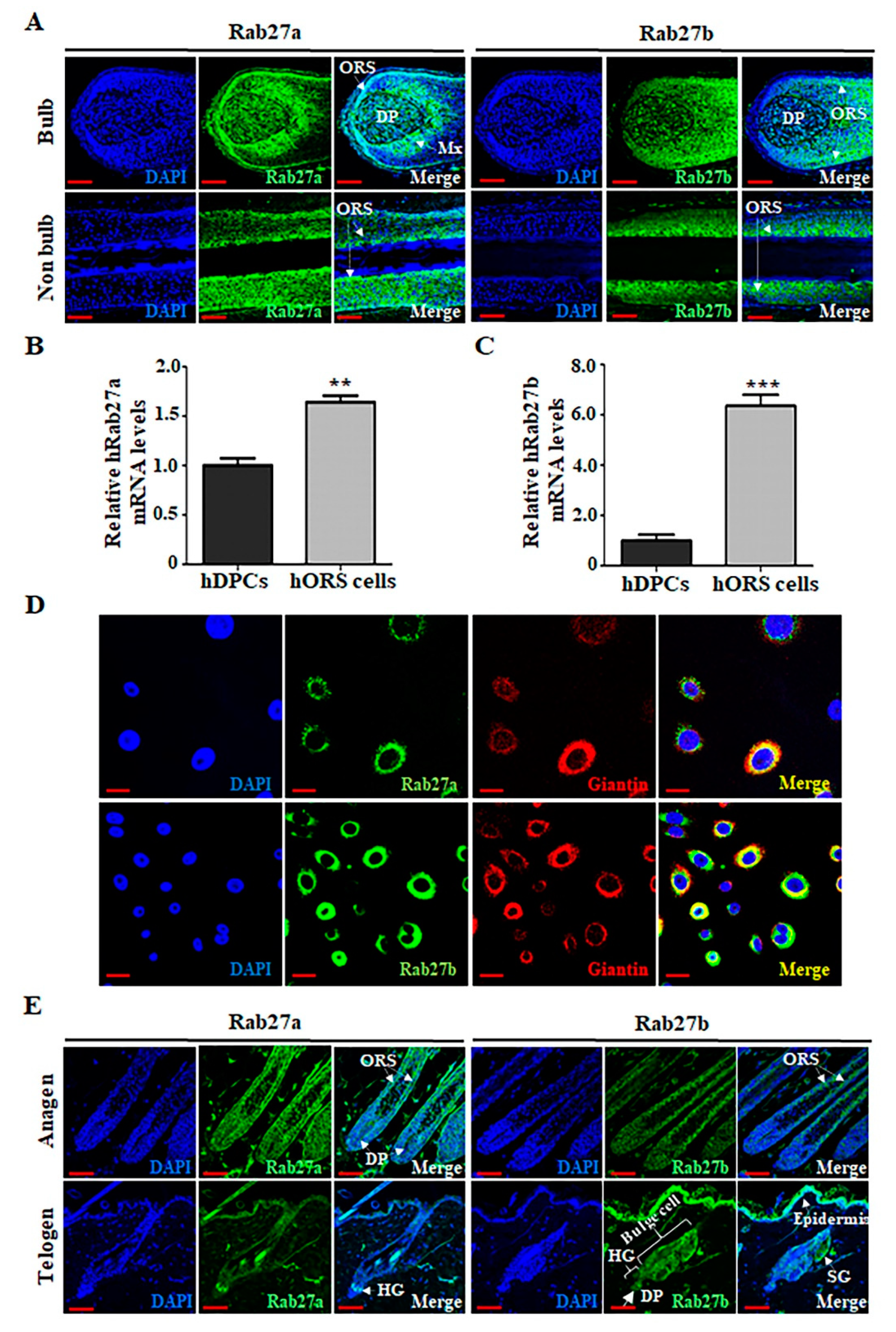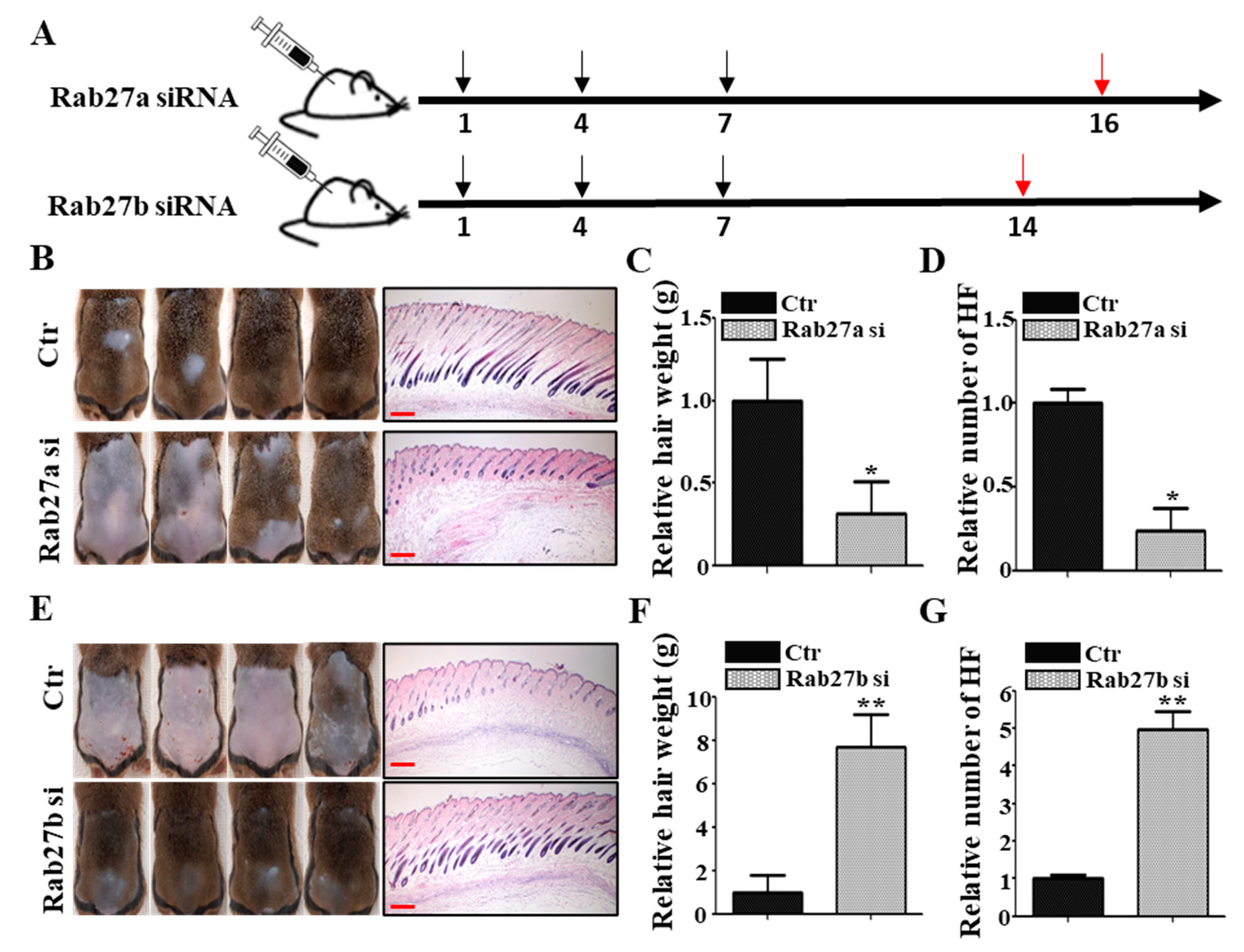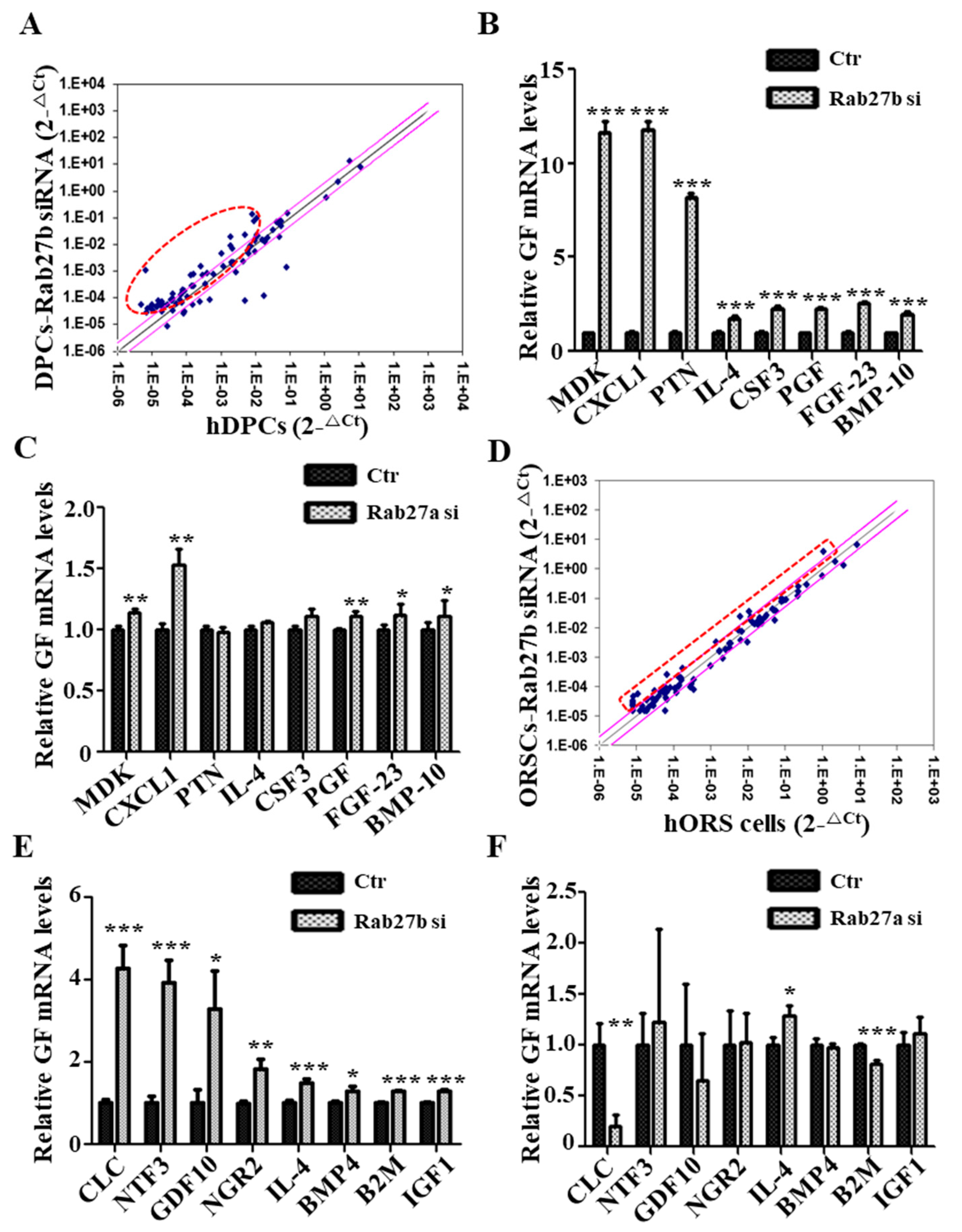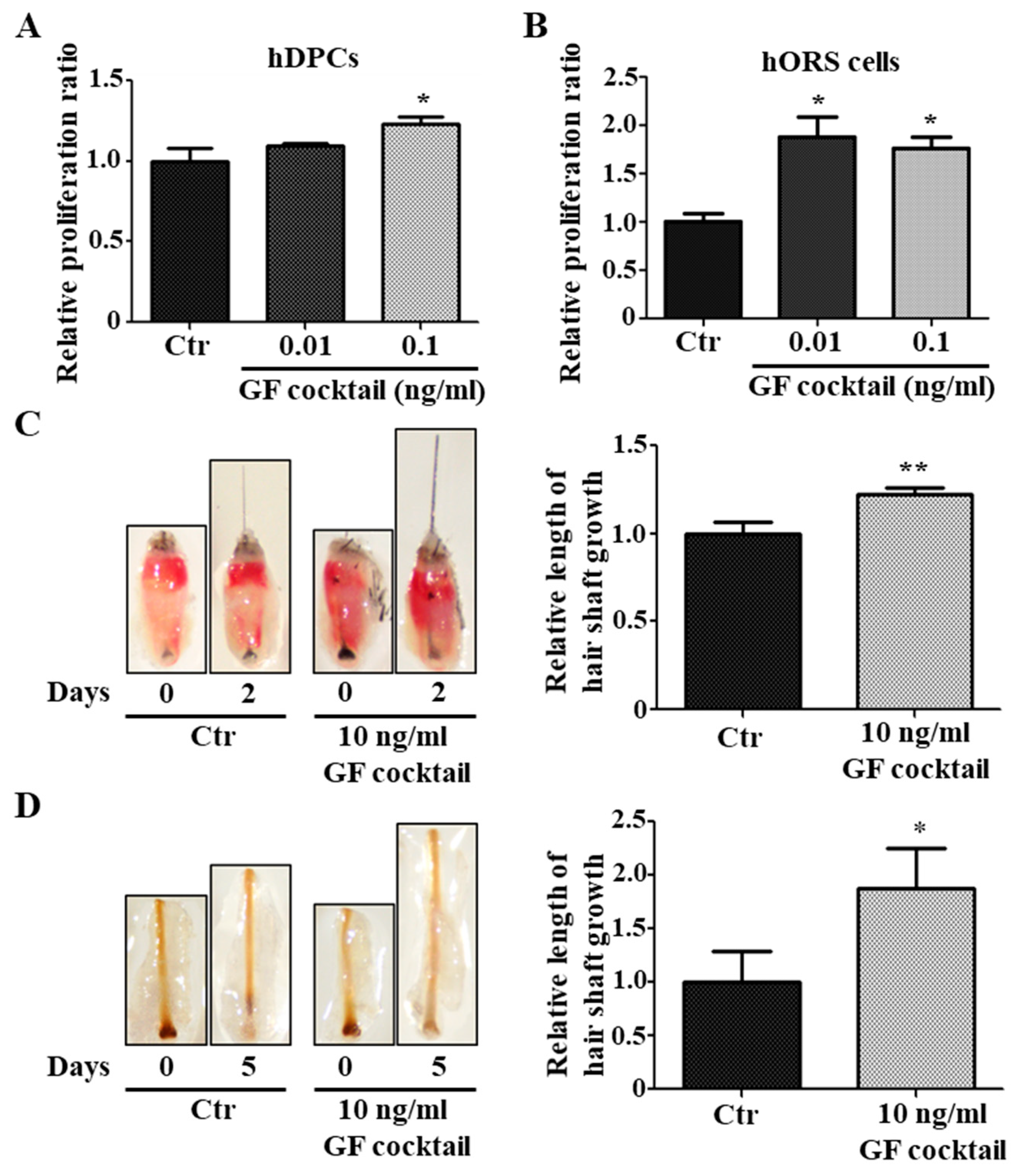Inhibition of Rab27a and Rab27b Has Opposite Effects on the Regulation of Hair Cycle and Hair Growth
Abstract
1. Introduction
2. Results
2.1. Rab27a and Rab27b Are Primarily Expressed in the ORS Cells
2.2. Inhibition of Rab27a or Rab27b Revealed Opposite Effects for Hair Growth
2.3. Inhibition of Rab27a or Rab27b Revealed the Opposite Effect for Mouse Vibrissae Growth
2.4. Inhibition of Rab27a or Rab27b Showed Opposite Mitogenic Effects in hORS Cells and hDPCs
2.5. Rab27b Inhibition Increased the Secretion of Multiple Growth Factors
2.6. Hair Growth Effect by Upregulated Growth Factors
3. Discussion
4. Materials and Methods
4.1. Cell Cultures and Chemical Treatment
4.2. siRNA Transfection
4.3. Mice
4.4. RNA Extraction and qRT-PCR
4.5. Growth Factor Polymerase Chain Reaction Array
4.6. Western Blot Analysis
4.7. Immunofluorescence Staining
4.8. Treatment of Growth Factors Cocktail
4.9. Cell Proliferation Assay
4.10. Scratch Migration Assay
4.11. Organ Culture
4.12. Anagen Induction
4.13. Hematoxylin and Eosin Staining
4.14. Statistical Analysis
Supplementary Materials
Author Contributions
Funding
Conflicts of Interest
Abbreviations
| hDPCs | Human dermal papilla cells |
| hORS cells | Human outer root sheath cells |
| Mx | Matrix cells |
| SG | Sebaceous gland |
| GF | Growth factor |
| MDK | Midkine |
| CXCL1 | chemokine (C-X-C motif) ligand 1 |
| PTN | Pleiotrophin |
| IL-4 | Interleukin-4 |
| CSF3 | Colony Stimulating Factor 3 |
| PGF | Placental growth factor |
| FGF-23 | Fibroblast growth factor 23 |
| BMP-10 | Bone morphogenetic protein 10 |
| CLC | Charcot-Leyden crystal protein |
| NTF3 | Neurotrophin 3 |
| GDF10 | Growth differentiation factor 10 |
| NRG2 | Neuregulin 2 |
| BMP4 | Bone morphogenetic protein 4 |
| B2M | Beta-2-microglobulin |
| IGF1 | Insulin-like growth factor 1 (somatomedin C) |
References
- Mounsey, A.; Reed, S.W. Diagnosing and treating hair loss. Am. Fam. Physician 2009, 80, 356–362. [Google Scholar]
- Phillips, T.G.; Slomiany, W.P.; Allison, R. Hair Loss: Common Causes and Treatment. Am. Fam. Physician 2017, 96, 371–378. [Google Scholar]
- Rogers, N.E. Hair transplantation update. Semin. Cutan. Med. Surg. 2015, 34, 89–94. [Google Scholar] [CrossRef]
- Elghblawi, E. Platelet-rich plasma, the ultimate secret for youthful skin elixir and hair growth triggering. J. Cosmet. Dermatol. 2018, 17, 423–430. [Google Scholar] [CrossRef]
- Schiavone, G.; Raskovic, D.; Greco, J.; Abeni, D. Platelet-Rich Plasma for Androgenetic Alopecia. Dermatol. Surg. 2014, 40, 1010–1019. [Google Scholar] [CrossRef]
- Zheng, M.; Jang, Y.-J.; Choi, N.; Kim, D.-Y.; Han, T.W.; Yeo, J.H.; Lee, J.; Sung, J.-H. Hypoxia improves hair inductivity of dermal papilla cells via nuclear NADPH oxidase 4-mediated reactive oxygen species generation. Br. J. Dermatol. 2019, 181, 523–534. [Google Scholar] [CrossRef]
- Choi, N.; Kim, W.-S.; Oh, S.H.; Sung, J.-H. HB-EGF Improves the Hair Regenerative Potential of Adipose-Derived Stem Cells via ROS Generation and Hck Phosphorylation. Int. J. Mol. Sci. 2019, 21, 122. [Google Scholar] [CrossRef]
- Schwartz, S.L.; Cao, C.; Pylypenko, O.; Rak, A.; Wandinger-Ness, A. Rab GTPases at a glance. J. Cell Sci. 2007, 120, 3905–3910. [Google Scholar] [CrossRef]
- Diekmann, Y.; Seixas, E.; Gouw, M.; Tavares-Cadete, F.; Seabra, M.C.; Pereira-Leal, J. Thousands of Rab GTPases for the Cell Biologist. PLoS Comput. Biol. 2011, 7, e1002217. [Google Scholar] [CrossRef]
- Catz, S.D. Regulation of vesicular trafficking and leukocyte function by Rab27 GTPases and their effectors. J. Leukoc. Biol. 2013, 94, 613–622. [Google Scholar] [CrossRef]
- Wood, S.M.; Meeths, M.; Chiang, S.C.; Bechensteen, A.G.; Boelens, J.J.; Heilmann, C.; Horiuchi, H.; Rosthøj, S.; Rutynowska, O.; Winiarski, J.; et al. Different NK cell–activating receptors preferentially recruit Rab27a or Munc13-4 to perforin-containing granules for cytotoxicity. Blood 2009, 114, 4117–4127. [Google Scholar] [CrossRef]
- Tolmachova, T.; Åbrink, M.; Futter, C.; Authi, K.S.; Seabra, M.C. Rab27b regulates number and secretion of platelet dense granules. Proc. Natl. Acad. Sci. USA 2007, 104, 5872–5877. [Google Scholar] [CrossRef]
- Fukuda, M. Rab27 Effectors, Pleiotropic Regulators in Secretory Pathways. Traffic 2013, 14, 949–963. [Google Scholar] [CrossRef]
- Singh, R.K.; Mizuno, K.; Wasmeier, C.; Wavre-Shapton, S.T.; Recchi, C.; Catz, S.D.; Futter, C.; Tolmachova, T.; Hume, A.N.; Seabra, M.C. Distinct and opposing roles for Rab27a/Mlph/MyoVa and Rab27b/Munc13-4 in mast cell secretion. FEBS J. 2013, 280, 892–903. [Google Scholar] [CrossRef]
- Johnson, J.L.; Brzezinska, A.A.; Tolmachova, T.; Munafo, D.B.; Ellis, B.A.; Seabra, M.C.; Hong, H.; Catz, S.D. Rab27a and Rab27b Regulate Neutrophil Azurophilic Granule Exocytosis and NADPH oxidase Activity by Independent Mechanisms. Traffic 2010, 11, 533–547. [Google Scholar] [CrossRef]
- Ostrowski, M.; Carmo, N.; Krumeich, S.; Fanget, I.; Raposo, G.; Savina, A.; Moita, C.F.; Schauer, K.; Hume, A.N.; Freitas, R.P.; et al. Rab27a and Rab27b control different steps of the exosome secretion pathway. Nat. Cell Biol. 2010, 12, 19–30. [Google Scholar] [CrossRef]
- Van Gele, M.; Dynoodt, P.; Lambert, J. Griscelli syndrome: A model system to study vesicular trafficking. Pigment. Cell Melanoma Res. 2009, 22, 268–282. [Google Scholar] [CrossRef]
- Mishra, K.; Singla, S.; Sharma, S.; Saxena, R.; Batra, V.V. Griscelli syndrome type 2: A novel mutation inRAB27Agene with different clinical features in 2 siblings: A diagnostic conundrum. Korean J. Pediatr. 2014, 57, 91–95. [Google Scholar] [CrossRef]
- Singh, R.K.; Furze, R.C.; Birrell, M.A.; Rankin, S.; Hume, A.N.; Seabra, M.C. A role for Rab27 in neutrophil chemotaxis and lung recruitment. BMC Cell Biol. 2014, 15, 39. [Google Scholar] [CrossRef]
- Haddad, E.K.; Wu, X.S.; Hammer, J.A.; Henkart, P.A. Defective Granule Exocytosis in Rab27a-Deficient Lymphocytes from Ashen Mice. J. Cell Biol. 2001, 152, 835–842. [Google Scholar] [CrossRef]
- Westbroek, W.; Lambert, J.; De Schepper, S.; Kleta, R.; Bossche, K.V.D.; Seabra, M.C.; Huizing, M.; Mommaas, M.; Naeyaert, J.M. Rab27b is Up-Regulated in Human Griscelli Syndrome Type II Melanocytes and Linked to the Actin Cytoskeleton via Exon F-Myosin Va Transcripts. Pigment. Cell Res. 2004, 17, 498–505. [Google Scholar] [CrossRef] [PubMed]
- Menasche, G.; Ho, C.H.; Sanal, O.; Feldmann, J.; Tezcan, I.; Ersoy, F.; Houdusse, A.; Fischer, A.; Basile, G. Griscelli syndrome restricted to hypopigmentation results from a melanophilin defect (GS3) or a MYO5A F-exon deletion (GS1). J. Clin. Investig. 2003, 112, 450–456. [Google Scholar] [CrossRef] [PubMed]
- Tobin, D. Aging of the Hair Follicle Pigmentation System. Int. J. Trichol. 2009, 1, 83–93. [Google Scholar] [CrossRef] [PubMed]
- Tobin, D.; Slominski, A.T.; Botchkarev, V.A.; Paus, R. The fate of hair follicle melanocytes during the hair growth cycle. J. Investig. Dermatol. Symp. Proc. 1999, 4, 323–332. [Google Scholar] [CrossRef]
- Trueb, R.M. Hormones and hair growth. Hautarzt 2010, 61, 487–495. [Google Scholar]
- Worst, T.S.; Meyer, Y.; Gottschalt, M.; Weis, C.-A.; Von Hardenberg, J.; Frank, C.; Steidler, A.; Michel, M.S.; Erben, P. RAB27A, RAB27B and VPS36 are downregulated in advanced prostate cancer and show functional relevance in prostate cancer cells. Int. J. Oncol. 2017, 50, 920–932. [Google Scholar] [CrossRef]
- Koh, H.M.; Song, D.H. Prognostic role of Rab27A and Rab27B expression in patients with non-small cell lung carcinoma. Thorac. Cancer 2018, 10, 143–149. [Google Scholar] [CrossRef]
- Thornton, M.J.; Hamada, K.; Randall, V.A.; Messenger, A.G. Androgen-Dependent Beard Dermal Papilla Cells Secrete Autocrine Growth Factor(s) in Response to Testosterone Unlike Scalp Cells. J. Investig. Dermatol. 1998, 111, 727–732. [Google Scholar] [CrossRef]
- Fujie, T.; Katoh, S.; Oura, H.; Urano, Y.; Arase, S. The chemotactic effect of a dermal papilla cell-derived factor on outer root sheath cells. J. Dermatol. Sci. 2001, 25, 206–212. [Google Scholar] [CrossRef]
- Limat, A.; Hunziker, T.; Waelti, E.R.; Inaebnit, S.P.; Wiesmann, U.; Braathen, L.R. Soluble factors from human hair papilla cells and dermal fibroblasts dramatically increase the clonal growth of outer root sheath cells. Arch. Dermatol. Res. 1993, 285, 205–210. [Google Scholar] [CrossRef]
- Urakova, N.; Strive, T.; Frese, M. RNA-Dependent RNA Polymerases of Both Virulent and Benign Rabbit Caliciviruses Induce Striking Rearrangement of Golgi Membranes. PLoS ONE 2017, 12, e0169913. [Google Scholar] [CrossRef] [PubMed]
- Jindo, T.; Imai, R.; Takamori, K.; Ogawa, H. Organ Culture of Mouse Vibrissal Hair Follicles in Serum-free Medium. J. Dermatol. 1993, 20, 756–762. [Google Scholar] [CrossRef] [PubMed]







© 2020 by the authors. Licensee MDPI, Basel, Switzerland. This article is an open access article distributed under the terms and conditions of the Creative Commons Attribution (CC BY) license (http://creativecommons.org/licenses/by/4.0/).
Share and Cite
Ku, K.-E.; Choi, N.; Sung, J.-H. Inhibition of Rab27a and Rab27b Has Opposite Effects on the Regulation of Hair Cycle and Hair Growth. Int. J. Mol. Sci. 2020, 21, 5672. https://doi.org/10.3390/ijms21165672
Ku K-E, Choi N, Sung J-H. Inhibition of Rab27a and Rab27b Has Opposite Effects on the Regulation of Hair Cycle and Hair Growth. International Journal of Molecular Sciences. 2020; 21(16):5672. https://doi.org/10.3390/ijms21165672
Chicago/Turabian StyleKu, Kyung-Eun, Nahyun Choi, and Jong-Hyuk Sung. 2020. "Inhibition of Rab27a and Rab27b Has Opposite Effects on the Regulation of Hair Cycle and Hair Growth" International Journal of Molecular Sciences 21, no. 16: 5672. https://doi.org/10.3390/ijms21165672
APA StyleKu, K.-E., Choi, N., & Sung, J.-H. (2020). Inhibition of Rab27a and Rab27b Has Opposite Effects on the Regulation of Hair Cycle and Hair Growth. International Journal of Molecular Sciences, 21(16), 5672. https://doi.org/10.3390/ijms21165672



